
BioMed Central
Page 1 of 11
(page number not for citation purposes)
Implementation Science
Open Access
Research article
From recommendation to action: psychosocial factors influencing
physician intention to use Health Technology Assessment (HTA)
recommendations
Marie-Pierre Gagnon*1, Emília Sánchez2 and Joan MV Pons2
Address: 1Evaluative Research Unit, Quebec University Hospital Centre, Quebec, Canada and 2Catalan Agency for Health Technology Assessment
and Research (CAHTAR), Barcelona, Spain
Email: Marie-Pierre Gagnon* - marie-pierre.gagnon@mfa.ulaval.ca; Emília Sánchez - esanchez@aatrm.catsalut.net;
Joan MV Pons - jpons@aatrm.catsalut.net
* Corresponding author
Abstract
Background: Evaluating the impact of recommendations based upon health technology assessment (HTA)
represents a challenge for both HTA agencies and healthcare policy-makers. Using a psychosocial theoretical
framework, this study aimed at exploring the factors affecting physician intention to adopt HTA
recommendations. The selected recommendations were prioritisation systems for patients on waiting lists for
two surgical procedures: hip and knee replacement and cataract surgery.
Methods: Determinants of physician intention to use HTA recommendations for patient prioritisation were
assessed by a questionnaire based upon the Theory of Interpersonal Behaviour. A total of 96 physicians from two
medical specialties (ophthalmology and orthopaedic surgery) responded to the questionnaire (response rate
44.2%). A multiple analysis of variance (MANOVA) was performed to assess differences between medical
specialties on the set of theoretical variables. Given the main effect difference between specialties, two regression
models were tested separately to assess the psychosocial determinants of physician intention to use HTA
recommendations for the prioritisation of patients on waiting lists for surgical procedures.
Results: Factors influencing physician intention to use HTA recommendations differ between groups of
specialists. Intention to use the prioritisation system for patients on waiting lists for cataract surgery among
ophthalmologists was related to attitude towards the behaviour, social norms, as well as personal normative
beliefs. Intention to use HTA recommendations for patient prioritisation for hip and knee replacement among
orthopaedic surgeons was explained by: perception of conditions that facilitated the realisation of the behaviour,
personal normative beliefs, and habit of using HTA recommendations in clinical work.
Conclusion: This study offers a model to assess factors influencing the intention to adopt recommendations
from health technology assessment into professional practice. Results identify determinant factors that should be
considered in the elaboration of strategies to support the implementation of evidence-based practice, with
respect to emerging health technologies and modalities of practice. However, it is important to emphasise that
behavioural determinants of evidence-based practice vary according to the specific technology considered.
Evidence-based implementation of HTA recommendations, as well as other evidence-based practices, should
build on a theoretical understanding of the complex forces that shape the practice of healthcare professionals.
Published: 31 March 2006
Implementation Science2006, 1:8 doi:10.1186/1748-5908-1-8
Received: 16 December 2005
Accepted: 31 March 2006
This article is available from: http://www.implementationscience.com/content/1/1/8
© 2006Gagnon et al; licensee BioMed Central Ltd.
This is an Open Access article distributed under the terms of the Creative Commons Attribution License (http://creativecommons.org/licenses/by/2.0),
which permits unrestricted use, distribution, and reproduction in any medium, provided the original work is properly cited.

Implementation Science 2006, 1:8 http://www.implementationscience.com/content/1/1/8
Page 2 of 11
(page number not for citation purposes)
Background
Health Technology Assessment (HTA) is a multidiscipli-
nary field of applied research that aims to provide the best
evidence available on health technologies in order to
inform policy-making [1,2]. In HTA, the definition of
health technology is broad and encompasses all methods
used by health professionals to promote health, prevent
and treat disease, and improve rehabilitation and long-
term care [3].
It is generally recognised that there is a gap between the
production of scientific evidence and its utilisation to
inform decision-making, [4], and this also applies to the
field of HTA [5-8]. Despite growing interest in HTA, both
in the governmental and scientific spheres, few efforts
have been made to assess HTA impact on decision-mak-
ing at different levels of the healthcare system [6]. Further-
more, there is a paucity of specific methodologies and
tools to assess the uptake of HTA recommendations [5].
At the health policy level, previous work has reported that
HTA recommendations could influence decision-making
[9-11]. According to a multi-method study of the imple-
mentation of guidance issued by the National Institute for
Clinical Excellence (NICE) in England and Wales, [12] the
extent to which HTA led to changes in practices was varia-
ble. Moreover, a review of HTA utilisation in four Euro-
pean countries indicates that, in spite of substantial
human and financial investments, the actual impact of
HTA on policy-making was still limited [13].
Hivon and collaborators have explored end-users' percep-
tions and use of HTA recommendations [14]. Their find-
ings indicate that knowledge produced from HTA was not
always used directly in decision-making, but could serve
various purposes. According to these authors, HTA recom-
mendations could have an instrumental, conceptual or sym-
bolic use in decision-making [14]. Instrumental use
implies that recommendations from HTA are directly
translated into a decision. HTA recommendations also
can have a conceptual use by providing a knowledge basis
for debate and positioning. Finally, decision-makers can
make a symbolic use of HTA recommendations, using
them to reinforce or justify their decisions. Thus, studies
assessing HTA utilisation should explore the various pur-
poses that scientific evidence can serve in the formulation
of healthcare policies.
At the healthcare organisations level, the implementation
of hospital-based HTA activities could represent a strategy
to improve practices [7]. Hospital-based HTA is believed
to provide scientific evidence that is context-relevant,
which would eventually lead to the adoption of best prac-
tices [15,16]. Experiences with HTA activities in hospitals
have reported positive impact on resources and costs [15].
Other experiences of decentralized HTA activities include
the implementation of units dedicated to HTA at the
regional health authority level, such as in Health Regions
in Canada [17]. However, evidence is still lacking on how
HTA activities should be integrated within healthcare
organisations [18].
Until now, little is known about the implementation of
HTA recommendations at the individual level, i.e. in the
daily practice of healthcare professionals. However, the
literature on physician adoption of scientific evidence and
interventions to improve it is extensive [19]. Thus, it is
possible to draw from this body of knowledge in order to
better understand the mechanisms involved in the adop-
tion of HTA recommendations into clinical practices.
Theoretical foundations
In the field of social psychology, various theories and
models have been proposed to understand what influ-
ences the adoption of behaviours. Triandis' Theory of
Interpersonal Behaviour (TIB) [20] encompasses many of
the behavioural determinants found in other psychosocial
theories, such as the Theory of Planed Behaviour [21] and
the Social Cognitive Theory [22]. Moreover, the TIB also
considers cultural, social, and moral factors that are par-
ticularly important in the study of specific groups, such as
healthcare professionals [23,24].
A schema adapted from the TIB is presented in Figure 1.
According to this theory, human behaviour is formed by
three components: intention, facilitating conditions, and
Theoretical ModelFigure 1
Theoretical Model Adapted from Triandis' Theory of
Interpersonal Behaviour [22]
Figures
Figure 1 - Theoretical Model
Adapted from Triandis’ Theory of Interpersonal Behaviour [22]
Tested hypothesis Non-tested hypothesis New hypothesis
Affect
HABIT
Perceived
consequences
INTENTION
FACILITATING
CONDITIONS
Personal
norm
BEHAVIOUR
Role
beliefs
Normative
beliefs
SOCIAL NORMATIVE
BELIEFS
Self -
identity
PERSONAL
NORMATIVE BELIEFS
ATTITUDINAL
BELIEFS
Profes-
sional
norm
Dimension added

Implementation Science 2006, 1:8 http://www.implementationscience.com/content/1/1/8
Page 3 of 11
(page number not for citation purposes)
habit. Intention refers to the individual's motivation
regarding the performance of a given behaviour. Facilitat-
ing conditions represent perceived factors in the environ-
ment that can ease or impede the realisation of a given
behaviour. Habit refers to how routine a given behaviour
has become, i.e. the frequency of its occurrence. Habit
directly influences the behaviour, but can also have an
influence on affect. However, this hypothesis was not
tested in the present study.
In the TIB, the behavioural intention is formed by attitu-
dinal as well as normative beliefs. Attitudinal beliefs com-
prise two dimensions: affect and perceived consequences.
Affect represents an emotional state that the performance
of a given behaviour evokes for an individual. It is consid-
ered as the affective perceived consequences of the behav-
iour, whereas perceived consequences refer to individual's
perception of the instrumental consequences of the
behaviour.
The TIB also distinguishes between two normative dimen-
sions: social and personal. Social normative beliefs are
formed by normative and role beliefs. Normative beliefs
consist of the internalisation by an individual of referent
people's or groups' opinions about the realisation of the
behaviour, whereas role beliefs reflect the extent to which
an individual thinks someone of his or her age, gender,
and social position should or should not behave. With
respect to the personal normative beliefs, personal norm
represents the feeling of personal obligation regarding the
performance of a given behaviour, whereas self-identity
refers to the degree of congruence between the individ-
ual's perception of self and the characteristics associated
with the realisation of the behaviour.
For the purpose of this study, modifications were brought
to the original TIB model. These modifications were con-
sistent with a previous study that has adapted the TIB to
understand healthcare professional behaviour [24]. First,
the dependent variable of interest in this study is the
behavioural intention rather than the behaviour. Thus,
the original relationships between facilitating conditions
and behaviour, as well as between habit and behaviour
have been modified to explore the influence of these con-
structs on the behavioural intention. These relationships
are consistent with previous studies that used the TIB to
predict behavioural intention [25-27].
Furthermore, in an effort to better adapt the TIB to health
professional behaviour, another dimension was added to
the personal normative beliefs – the professional norm. This
variable is related to the integration by the self of the spe-
cific normative pressures of one's professional group. The
medical profession has a particular culture and sets of
norms (e.g. the Hippocratic Oath) that also influence
individual physician behaviour [28]. In a previous study,
adding the professional norm to the personal normative
construct significantly improved the predictive validity of
this construct in explaining physicians' decision to adopt
a new technology [24]. This construct is also consistent
with the concept of collective self, as proposed by Triandis,
which corresponds to the individual's assessment of how
she or he should behave given her or his belonging to a
specific reference group [29]. The professional norm is
considered a of the dimension of the personal normative
construct since previous work has shown association
between these factors [24].
To the best of our knowledge, the TIB has not previously
been applied to the study of the adoption of evidence-
based recommendations into medical practice. However,
this model was successful in explaining a variety of profes-
sional behaviours, such as the adoption of information
and communication technologies [24,25,30,31].
Description of the study
This study is part of a larger initiative aimed at applying a
multi-dimensional theoretical framework to assess the
impact of HTA recommendations on decision-making at
different levels of the healthcare system. Thus, various
methods were used in order to assess factors influencing
the uptake of HTA recommendations at the healthcare
organisation and clinical decision-making levels. HTA
adoption at the organisational level was assessed through
a qualitative approach by means of interviews and obser-
vations at 15 hospitals of Catalonia. The results of the
qualitative study are presented elsewhere [32,33].
In summary, the qualitative study indicates that factors
related to the organisation and financing of the health sys-
tem influence adoption of HTA recommendations at the
hospital level. Furthermore, collaborations between hos-
pitals and the HTA agency favour the integration of rec-
ommendations into organisational practices. At the
professional level, the high degree of autonomy of medi-
cal specialists, the importance of peers and collegial con-
trol, and the definition of professional roles and
responsibilities influence adoption of HTA recommenda-
tions.
The present article focuses on the impact of HTA recom-
mendations at the individual level, which has been con-
ceptualised as physician intention to use HTA
recommendations to support clinical decision-making.
This study was conducted as part of a postdoctoral fellow-
ship (MPG), and the research protocol was approved by
Catalonia and Quebec governments. The Catalan Agency
for Health Technology Assessment and Research
(CAHTAR) also reviewed the research protocol and pro-
vided support for the study.

Implementation Science 2006, 1:8 http://www.implementationscience.com/content/1/1/8
Page 4 of 11
(page number not for citation purposes)
Research Questions
Based upon the TIB, this study aimed to answer the fol-
lowing questions:
1. Which psychosocial factors from the TIB (attitudinal
beliefs, social normative beliefs, personal normative
beliefs, facilitating conditions, habit) significantly explain
the intention of physicians to adopt these recommenda-
tions into their practice?
2. Are the psychosocial factors influencing physicians'
intention to adopt HTA recommendations significantly
different between the two groups of specialists?
3. Do sociodemographic and professional factors (age,
gender, work experience) influence physicians' intention
to adopt HTA recommendations over and above the psy-
chosocial constructs from the TIB?
Methods
Selection of health technologies
A consensus was reached with researchers from the
CAHTAR to select which recommendations would be
investigated. The criteria used in the selection were: 1)
publication time sufficient for the HTA recommendation
to have been largely disseminated; 2) recommendations
representing administrative and clinical health technolo-
gies, since the literature reports important variations in
factors affecting the adoption of these two types of inno-
vations;[34] and 3) similar recommendations that would
allow comparisons between cases for a greater internal
validity. Thus, a total of three recommendations were
selected. Two were related to clinical-administrative tech-
nologies, namely prioritisation systems for patients on
waiting lists for two distinct surgical procedures – cataract
surgery and hip and knee replacement. The third recom-
mendation covered the prescription of external pump for
continuous subcutaneous insulin infusion for patients
with Type I diabetes. However, it was not possible to ana-
lyse the factors affecting the adoption of this recommen-
dation quantitatively, given the limited number of
endocrinologists (7) in the sample. Thus, only the recom-
mendations regarding the two prioritisation systems were
considered in the analysis of HTA recommendations'
impact at the individual decision-making level.
Both recommendations proposed a scoring system to
assess patient priority on waiting lists for the targeted sur-
gical procedures. The prioritisation systems for cataract
surgery and hip and knee replacement were similar,
although specific scoring items were used. Their utilisa-
tion by physicians practicing in the Catalan network of
public hospitals was made mandatory through an instruc-
tion issued by the Servei Català de la Salut (the Catalan
Health Service) in November 2004.
Development of the survey instrument
The field of social psychology has a long tradition in the
development of survey instruments based upon theoreti-
cal frameworks. In the present study, questionnaire devel-
opment was based on several theorists' recommendations
[21,35,36]. The TIB provided the conceptual constructs
that were measured, but we adapted the content (i.e.
wording of the questions) to the specific behaviour under
study and the particular culture of the target group. This is
known in anthropology as the emic-etic approach and has
been recommended by psychosocial theorists in order to
ensure the cultural sensitivity of a study [37,38].
First, an open-ended questionnaire was prepared in order
to assess the modally salient beliefs in the study popula-
tion with respect to the behaviour under consideration.
Salient beliefs are the first responses to come to a respond-
ent's mind when asking an open-ended question. There-
fore, modally salient beliefs are the most frequently
reported beliefs regarding the attributes of performing a
particular behaviour in the target group [39]. Thus, a pur-
posive sample of 10 physicians within each medical spe-
cialty was sent a questionnaire comprising eight open-
ended questions. Questions assessed the attitudinal,
social normative and personal normative beliefs, as well
as the perceived facilitating conditions and barriers with
respect to using HTA recommendations to support deci-
sion-making.
Completed questionnaires were received from five oph-
thalmologists and seven orthopaedic surgeons. Responses
were compiled for each specialty. A content analysis was
performed to classify responses into thematic categories.
Then the number of responses in each category was com-
piled, and those having a frequency of two or more were
kept as the modally salient beliefs. These salient beliefs
were used as the items to assess each theoretical construct
of the TIB. A specific questionnaire was developed for
each medical specialty, since two distinct recommenda-
tions were addressed. However, given the similitude
between these recommendations, the two questionnaires
used the same items to assess theoretical constructs, thus
allowing for the combination of results and comparisons
between groups.
The first page of the questionnaire presented the study
and gave instructions to participants. A sentence indicated
that returning the questionnaire implied informed con-
sented to participate in the study. The questionnaire
began with a vignette describing a clinical case for which
the surgical procedure (cataract surgery or hip and knee
replacement) was relevant. By referring to the case pre-
sented in the vignette, physicians were asked to answer a
total of 30 questions measuring the theoretical constructs
of the TIB.

Implementation Science 2006, 1:8 http://www.implementationscience.com/content/1/1/8
Page 5 of 11
(page number not for citation purposes)
Each theoretical item was assessed by a question meas-
ured on a five-point Likert scale. For example, to what
extent do you agree with the following affirmation – "It
would be easy for me to use CAHTAR's recommendations to
support my decision in this case." 1) Totally disagree; 2)
Slightly disagree; 3) Neither agree nor disagree; 4) Slightly
agree; or 5) Totally agree. The only exception was for the
items composing the attitudinal construct that were
assessed by means of 5-point bi-polar adjective scales. For
example, "For me, using CAHTAR's recommendations to sup-
port decision-making in this case would be..." 1) Very foolish;
2) Somewhat foolish; 3) Neither foolish nor wise; 4)
Somewhat wise; or 5) Very wise. The number of items
used to assess each theoretical construct and their internal
consistency are provided in Table 1. The Cronbach α was
used to verify the internal consistency of theoretical con-
structs. As shown in Table 1, all constructs showed satis-
factory internal consistency, with Cronbach α higher than
0.70 [40].
Finally, socio-demographic information (age group, gen-
der, years of clinical experience, and medical specialty) was
collected at the end of the questionnaire. The question-
naire was pre-tested with two physicians of each specialty
in order to assess face validity and duration. Subse-
quently, minor adjustments were done to the wording of
some questions. The questionnaire took approximately
15 minutes to complete.
Participants and setting
A total of 15 hospitals were selected to most fully repre-
sent the various profiles of Catalan hospitals. Hospitals
from the eight Catalan Health Regions were represented.
The sample consisted of publicly and privately-funded
hospitals (all provided services in the public system), as
well as large teaching hospitals and smaller general hospi-
tals. Heads of department or service for the targeted spe-
cialties (ophthalmology and orthopaedic surgery) were
identified in each hospital as the local collaborators. The
principal investigator contacted them by telephone to
describe the study and solicit their participation. After
receiving consent from all contacted persons, a package
containing study questionnaires corresponding to the
number of physicians who worked in the service was
delivered to the local collaborator in each hospital. The
total sample consisted of 217 physicians (80 ophthalmol-
ogists and 137 orthopaedic surgeons).
Statistical analyses
First, descriptive analyses of distribution were conducted.
Correlations between theoretical variables and between
theoretical and external variables were assessed and are
reported in Table 2. All the theoretical constructs from the
TIB had a significant positive association with the inten-
tion. Medical specialty was the only external variable hav-
ing a significant correlation with theoretical variables.
None of the external variables were significantly corre-
lated with intention.
Second, a comparison between the two groups of special-
ists was performed on the set of theoretical variables using
the multivariate analysis of variance (MANOVA). Given
the significant differences between groups, two independ-
ent hierarchical regression models were tested in order to
assess the determinants of physician intention to use HTA
recommendations. The potential impact of external varia-
bles (socio-demographic and professional characteristics)
on intention was tested following Pedhazur's recommen-
dation, which consists of comparing the R2 of the model
containing only theoretical variables with the R2 of a
model also containing external variables [41]. No signifi-
cant difference was found. We also assessed potential
interaction effects of external variables by entering interac-
tion terms between theoretical and external variables that
were significantly correlated (e.g. attitude and experience
in the orthopaedic surgeons group) in the regression
equation [42], but no significant effect was found for the
interaction terms. The final regression models were calcu-
lated by keeping only the significant predictors in the
equation. All statistical analyses were performed using
SPSS version 12.0. (SPSS Inc., Chicago, IL)
Results
Descriptive statistics
A total of 96 physicians returned completed question-
naires (35 ophthalmologists and 61 orthopaedic sur-
geons) for a global response rate of 44.2%. Table 3
presents the sociodemographic and professional charac-
Table 1: Internal consistency of theoretical constructs
Construct Number of items Internal consistency (Cronbach's alpha)
Intention 3 0.85
Attitudinal beliefs 7 0.81
Personal normative beliefs 6 0.86
Social normative beliefs 6 0.82
Facilitating conditions 3 0.75
Habit 4 0.87


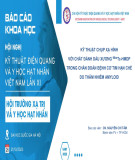
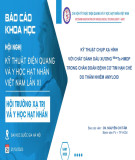
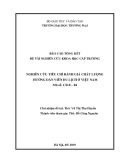
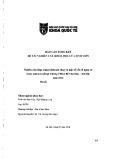
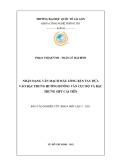
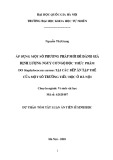
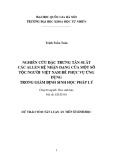

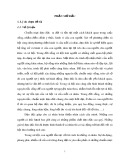





![Báo cáo seminar chuyên ngành Công nghệ hóa học và thực phẩm [Mới nhất]](https://cdn.tailieu.vn/images/document/thumbnail/2025/20250711/hienkelvinzoi@gmail.com/135x160/47051752458701.jpg)









